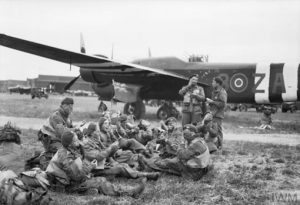This section of the website is so dedicated to the Albemarle aircraft and all the women and men who gave their life onboard for our freedom.
Probably described in the books as one of the least loved aircraft of WWII, the Armstrong Whitworth Albemarle is more than worthy of your attention. How can we explain that, by example, Plt Off Cunningham (297 Squadron) at 80 years old always speaked about the Albemarle with great affection!
Kenneth Frere (296 Squadron) also wrote: “It was fun to fly, it looked good and I am sorry that not a single example remains with us today.”

First and only nose-wheel aircraft built in Great Britain during WWII, the Albemarle was one of the first planes assigned to the airborne troops and so participated to nearly all the british airbone operations, the invasion of Sicily, it was the first aircraft to take off during D-Day, the night of 05 to 06 June 1944 with pathfinders onboards and after with gliders. It participated to Operation Market Garden in September 1944, it dropped agents and soldiers. The Albemarles also supplied the resistance forces, the SAS and the SOE (Winston Churchill’s Special Operations Executive) in occupied Europe.
How many WWII aircraft of the same model are represented in Museums but no Albemarle, no Stirling (the Royal Air Force’s first operational four-engined bomber), no Whitley (the first heavy bomber monoplane with retractable landing-gear, the first plane with airborne radar to fight against ships and the first plane in RAF to be used for paratroopers!), …
Only a few photos exist but no examples of these three aircraft (with technics never found before on other planes) survived.
In the same mind, please, read this extract about workers in MG factory during WWII :
“Abingdon assembled the complete front end, or cockpit of the Albemarle. One of the most interesting features of the A.W. 41 was the electrical testing gear.

Of particular interest was the assembly of the front end and cockpit of the Albemarle aircraft, the A.W. 41. The photograph (left) shows a line up of some of the people involved in its manufacture. Cis Cousins is third from the left. The Albemarle is interesting for a number of reasons:
I. It was one of the first contracts obtained by Cecil Kimber at the beginning of the war. He obtained the contract at his own initiative since he was desperate to find work for the M.G. factory and its employees.
2. It was this contract, according to McComb, that led him into conflict with the Nuffield Organisation who, themselves, specifically Sir Miles Thomas, Chairman, wanted to organise the war work for the whole of the Nuffield factory structure. This led to Kimber’s dismissal from M.G. and George Propert, a long time M.G. manager with a works management background, took over as General Manager, while H.A. Ryder was nominated as M.G. Managing Director.
3. The second reason for the interest is that the front end of the Albemarle aircraft was far more complex than any car ever produced by M.G.. In particular the front end contained the cockpit and all the pilots’ and navigators’ control systems which had eventually to be connected to the rest of the aircraft in another factory. In order to ensure that this front end was properly assembled and that all controls would work, the inspection team at M.G. devised an ingenious test rig for testing the completed aircraft front end before delivery to customers. A write-up of this electrical test rig was made in September 1942 and given to Works Superintendent Bill Slingsby who would eventually transmit this to the Autocar magazine. I am not sure at this stage whether the Autocar ever published it.
The new test rig allowed the Albemarle nose section to be fully and accurately tested in a single hour. This method replaced an old “bell and battery” method, described as rather hit and miss, which used to take three days for each front end. Apparently, the new rig worked so well and so impressed other aircraft companies that at the end of the war it was sold to the aircraft industry for use in peace time aircraft production. In all, 653 of these Albemarle aircraft units were made. Each nose section required as much work as the construction of a complete fighter aircraft.”

| Manufacture of Albemarle G1 Units | 653 |
| Man. of Spares Details for Albemarle G1 Units | 500,000 |
| Man. of Oil Cooler Mountings for Albemarle | 300 sets |
| Converting G1 Units | 202 |
The original MG text written by David Allen was hosted on the mgcars.org.uk but seems to have been removed since.
Next page: Armstrong Albemarle aircraft

